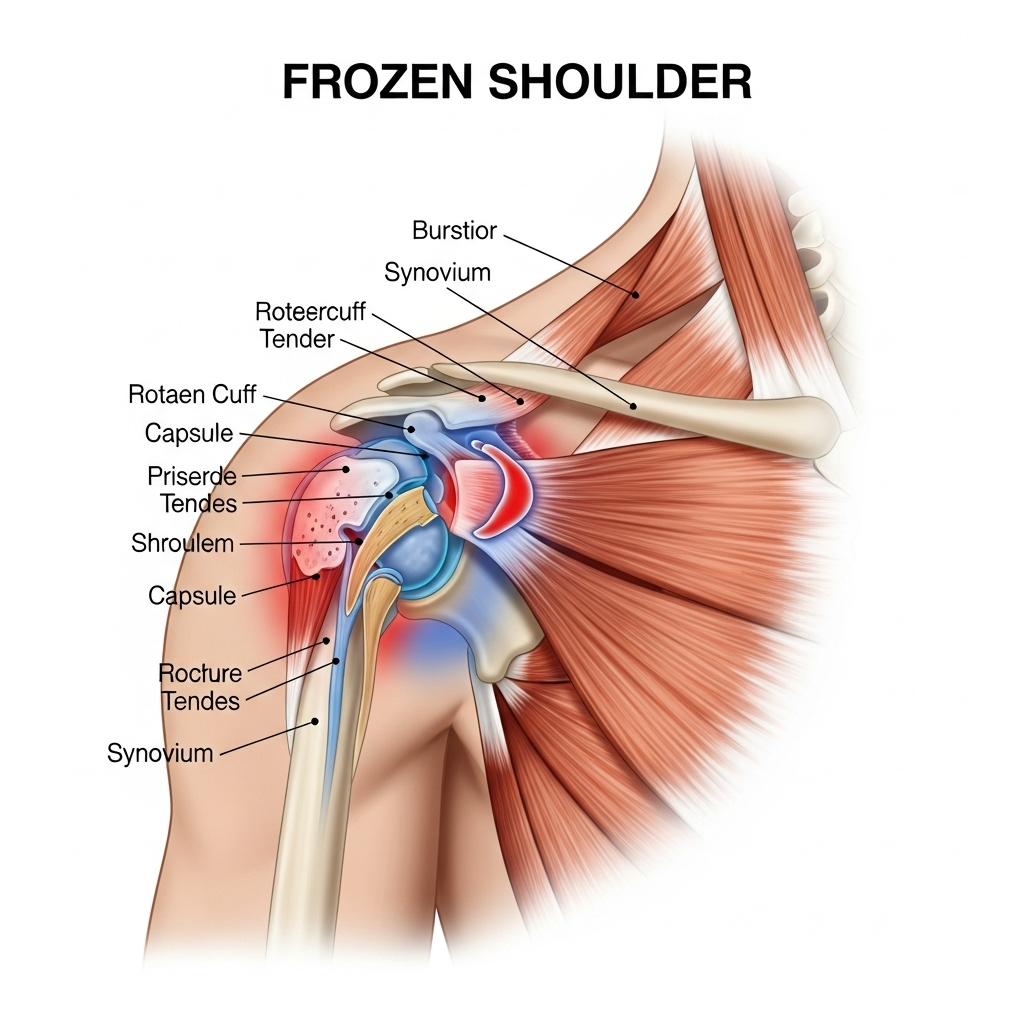Frozen shoulder, medically known as adhesive capsulitis, is a notoriously painful and debilitating condition that severely restricts shoulder movement. It progresses through distinct stages – freezing, frozen, and thawing – each characterized by increasing pain and stiffness, followed by a gradual return of motion.
While the exact cause can be elusive, it often stems from inflammation and thickening of the connective tissue surrounding the shoulder joint, forming adhesions that “freeze” the joint. For individuals grappling with this frustrating condition, dry needling has emerged as a promising and effective treatment option.
What is Frozen Shoulder?
Frozen shoulder manifests as persistent pain and a progressive loss of both active and passive range of motion in the shoulder. Simple daily tasks, from reaching overhead to dressing, can become excruciatingly difficult. The condition can significantly impact quality of life, making even basic movements a challenge.
The three stages of frozen shoulder typically unfold as follows:
Freezing Stage: This initial phase can last from 6 to 9 months, marked by a gradual onset of pain that worsens over time, leading to increasing stiffness.
Frozen Stage: Lasting 4 to 12 months, pain may lessen during this stage, but the stiffness remains severe, significantly limiting shoulder mobility.
Thawing Stage: This final stage, which can take 6 months to 2 years, sees a gradual improvement in shoulder movement and a reduction in stiffness as the shoulder slowly recovers.
The Role of Dry Needling in Frozen Shoulder Treatment
Dry needling is a therapeutic technique performed by trained practitioners, typically physical therapists, where thin, sterile needles are inserted into specific “trigger points” within the muscles. Unlike acupuncture, which is rooted in traditional Chinese medicine and focuses on energy pathways (meridians), dry needling is based on Western anatomical and physiological principles, targeting myofascial trigger points and muscle dysfunction.
In the context of frozen shoulder, dry needling primarily aims to address the muscle tightness, pain, and connective tissue restrictions that contribute to the limited mobility. The process involves:
Identifying Trigger Points: A thorough physical examination is conducted to locate hyper-irritable spots or taut bands within the muscles surrounding the shoulder, such as the rotator cuff, deltoid, upper trapezius, and subscapularis.
Needle Insertion: Fine, solid filament needles are carefully inserted directly into these identified trigger points.
Local Twitch Response: Upon insertion, the needle may elicit a “local twitch response,” which is an involuntary muscle contraction. This response is often an indicator that the needle has effectively targeted the trigger point and is helping to release muscle tension.
Muscle Relaxation and Blood Flow: The insertion of the needle helps to relax the constricted muscle fibers, improving blood flow and oxygenation to the area. This can promote tissue healing and reduce inflammation.
Benefits of Dry Needling for Frozen Shoulder
The benefits of incorporating dry needling into a comprehensive treatment plan for frozen shoulder are numerous and can significantly accelerate recovery:
Pain Relief: One of the most immediate and significant benefits is the reduction of pain. By releasing trigger points and easing muscle tension, dry needling can alleviate both acute and chronic shoulder discomfort. It can also stimulate the body’s natural pain-relief processes by prompting the release of endorphins.
Improved Mobility and Range of Motion: Frozen shoulder’s hallmark is limited movement. Dry needling directly addresses the muscular restrictions and connective tissue tightness that restrict motion, allowing for a greater range of movement in the shoulder joint. This improved flexibility can also make subsequent stretching and exercises more effective.
Reduced Muscle Tension and Stiffness: The technique helps to “deactivate” tight, knotted muscle fibers, leading to a noticeable decrease in overall muscle tension and stiffness around the shoulder.
Faster Recovery: When combined with other physiotherapy techniques like targeted exercises, manual therapy, and stretching, dry needling can accelerate the recovery process by addressing both the pain and the underlying mobility limitations.
Minimized Muscle Compensations: Frozen shoulder often leads to other muscles compensating for the restricted movement, creating further imbalances and pain. Dry needling can help relax these overactive compensating muscles, promoting better overall shoulder mechanics.
Is Dry Needling Safe and Effective?
When performed by a trained and licensed physical therapist or healthcare professional, dry needling is considered a safe and effective treatment for frozen shoulder.
It’s important to note that dry needling is often most effective when integrated into a holistic treatment approach that includes physical therapy exercises, stretching, and other modalities. If you are struggling with frozen shoulder, consulting with a qualified healthcare professional can help determine if dry needling is a suitable option for your specific condition and guide you toward a personalized recovery plan. Clinics like Don Kelly Physiotherapy and Acupuncture, with locations in Limerick and Charleville, are examples of practices that offer dry needling as part of their comprehensive physiotherapy services.
Ready to Find Relief from Frozen Shoulder?
If you’re experiencing the pain and limited movement of frozen shoulder, you don’t have to suffer in silence. Dry needling, as part of a comprehensive physiotherapy plan, could be the key to unlocking your shoulder’s mobility and restoring your quality of life.
Take the first step towards recovery today. Contact a qualified physiotherapy clinic, such as Don Kelly Physiotherapy and Acupuncture in Limerick or Charleville, to discuss if dry needling is the right treatment option for you.
Don’t let frozen shoulder keep you frozen in pain. Explore your options and move towards a more comfortable, mobile future.


